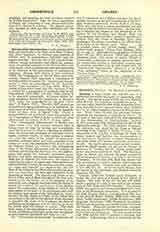

Caeremoniale Episcoporum, a book containing the rites and ceremonies to be observed at Mass, Vespers, and other functions, by bishops and prelates of inferior rank, in metropolitan, cathedral, and collegiate churches. It treats also of the manner of precedence among ecclesiastics and official lay persons. From the earliest centuries of the Church there were many books which contained the rites and ceremonies to be observed in the performance of ecclesiastical functions. Shortly after Sixtus V had instituted (1587) the Congregation of Sacred Rites and Ceremonies, Clement VIII appointed a commission of learned prelates to correct the “Caeremoniale Episcoporum”, which he promulgated by the Apostolic Letter “Cum novissime”, July 14, 1600. When in course of time errors crept into this, Innocent X had it revised by a commission of cardinals, and by his Constitution “Etsi alias” (July 30, 1650) ordered it to be observed everywhere. A revised edition became necessary during the pontificate of Benedict XIII, which was promulgated by the Bull “Licet alias” (March 7, 1727). Benedict XIV caused an amended and augmented edition to be published, the observance of which he made obligatory by Apostolic Briefs (May 15, 1741; March 25, 1752). Finally a typical edition was published under the auspices of the Congregation of Sacred Rites to which all other editions were to conform (S. R. C., August 17, 1886).
The “Caeremoniale Episcoporum” is divided into three books. The first portion concerns what a bishop must do after his election and immediately upon entrance into the diocese, regarding his ordinary dress, his duties and privileges, as indicated, when a legate, cardinal, nuncio, or other prelate is present (cc. i-iv); the duties of the master of ceremonies, sacristan, assistant priest, and other ministers of the bishop (cc. v-xi); the ornaments of the church and of the bishop’s throne (cc. xii-xiv); the ecclesiastical dress of the bishop and canons, and the manner of entering and leaving the church (c. xv); the pallium, mitre, and crosier (cc. xvi-xvii); reverences, genuflexions, and other ceremonies, and sermons during Mass and at funerals (cc. xviii-xxv); the manner of supplying the places of canons and other ministers at solemn services (c. xxvi); the orations and their chant, the organ and organist (cc. xxvii-xxviii); the low Mass of the bishop or low Mass celebrated in his presence (cc. xxix-xxx); the rites and ceremonies to be observed at synods. The second book treats of the Divine Office and of Mass throughout the year celebrated (a) by the bishop; (b) in his presence; (c) in cathedrals and collegiate churches when the bishop is absent (cc. i-xxxiv); the anniversary of the election and of the consecration of the bishop (c. xxxv); the anniversary of the death of his predecessor and of all the bishops and canons of the cathedral (cc. xxxvixxxvii); the last illness and death of the bishop and the prayers to be said for the election of his successor (c. xxxviii); the chant of the Confiteor, the form of Gregorian Armenians, 1200 Protestant Armenians, publishing an indulgence, and the blessing given by the bishop after the sermon (c. xxxi); The third book treats of the formalities to be observed by provincial presidents, prelatic governors, and vice-legates in their respective provinces and cities (cc. i-xi).
The “Caeremoniale Episcoporum” is obligatory not only in cathedrals and collegiate churches, but also in smaller churches, as far as it is applicable to the liturgical functions performed therein (S. R. C., August 17, 1894), not only when a bishop pontificates, but also when a priest performs the ceremony. In this manner it explains and makes up the deficiencies in the rubrics of the Breviary and Missal. That the “Caeremoniale Episcoporum” obliges in conscience is evident from the words of Benedict XIII, who, speaking of the rubrics contained in the official liturgical books of the Church, says: “Ritus qui in minimis etiam, sine peccato negligi, omitti vel mutari haud possunt” (Conc. Prov. Roman., 1725, tit. xv, cap. i). Although the Congregation of Sacred Rites (August 19, 1651) decreed: “Nihil addi, minui vel immutari posse, sed omnia in eodem Missali et Caeremoniali praescripta ad unguem servanda esse”, yet ceremonials peculiar to individual churches may retained, provided they do not conflict with the “Caeremoniale Episcoporum” (Sixtus V in his Bull “Cum novissime” found at the beginning of the “Caerem. Episc.”).
A. J. SCHULTE

